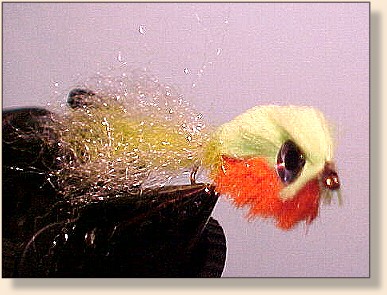Hillfisher Perch
By Hillfisher, Texas
Ever tour a hobby store and look at all the available
materials while in your mind, see if any of it will
produce a fly? Will it make it easier task of an already
established pattern or perhaps the creation of something
entirely new? I tie several non-traditional flys with "different"
materials. Some of the flys come out looking very nice. Some
just never make past the first try. But one rule I do have
and that is "If does not catch fish, it's not a fly." By this
I mean, anyone can tie up some really great looking new patterns,
but if it does not produce fish then it's just a fly pattern
model. Let put this into perspective, I used to teach rocketry
to the Boy Scouts so they could earn their aerospace patch.
The major requirement was the models, no matter how great
looking they were, they had to successfully fly in order to
qualify. This applies to all my flys, no matter how great it
looks, if it does not catch fish, you will not see it in this
magazine. Fortunately living in the south, I do not have to
wait all winter before finding out if they work.
Not far from my house is a Hobby Lobby, which is a large hobby
shop. I spend a lot of time going through all their wares
looking for material which can be used in tying flys. Recently
they received some new material and as I was walking by I got
this great image in my head, bought a few packs and headed home.
For those of you who enjoy pipe smoking, there is a pipe cleaner
made of wire and stiff synthetic material for cleaning the stems.
For the hobbyist this same material, also called Chenille, comes
in multitudes of color in the local hobby shops. Also for the
hobbyist it comes in various shapes as well. For fly tying the
odd shaped chenille produce some nice flys. What is interesting
is that it is called Chenille but this has a somewhat stiff wire
core. The wire core can actually be a bonus as it gives additional
weight to help hold the fly down in the currents of a river or creek.
Due to the stiffness of the wire, the body of the fly created with
this material should not extend beyond the bend of the hook. If
the wire does extend past the bend of the hook two things can result,
one the wire can injure the fish and two, it would not allow the
hook to get in far enough past the lips for a hook up.
These can be tied in many sizes with the ability to use large
long shank hooks down to the small shorter shanked hooks. By
trimming, adding and mixing various colors of this material,
some very effective patterns can be created. I have found
these to be effective for panfish in particular Crappie. The
larger patterns are effective for bass. I also see some potential
for saltwater patterns to emerge from this material as well.
Materials: Hillfisher Perch

Hook: MUSTAD 36620 4 - 10.
Thread: 6/0 color to match pattern.
Optional: Tail section color matching flat floss.
Body: Cut, shaped and trimmed wire
chenille. Color varies with patterns.
Tail: Marabou Hair or Krystal wing flash.
Color to match pattern chosen.
Eyes: Self-sticking Prismatic Eyes.
Tying Steps:

1. Select hook size and lay a bed of thread leaving
the bobbin just behind the eye of the hook. Select
underbody color and trim to size of hook.

2. Tie in the bottom body chenille just behind the
hook. (in this case orange)

3. Lay top body chenille (green) on top of hook and tie
in just behind the eye. Now with the "Head" tied in lift
up the rear of the top body and drop the rear of the bottom
body. Wrap the thread along the hook back towards the bend.
Bring the "rears" back to the hook and tie in.

4. Mix Marabou colors (white and green) to give tail the
correct color blend. Tie on to hook as close as possible
to chenille body. Leave enough for the end hair to flare
out and mix with body. Optional to add flat floss.


5. Add self sticking prismatic eyes, doll eyes or iridescent eyes.
This pattern can be modified in a variety of ways. Below
are just a couple of examples.



~ Hillfisher
|



